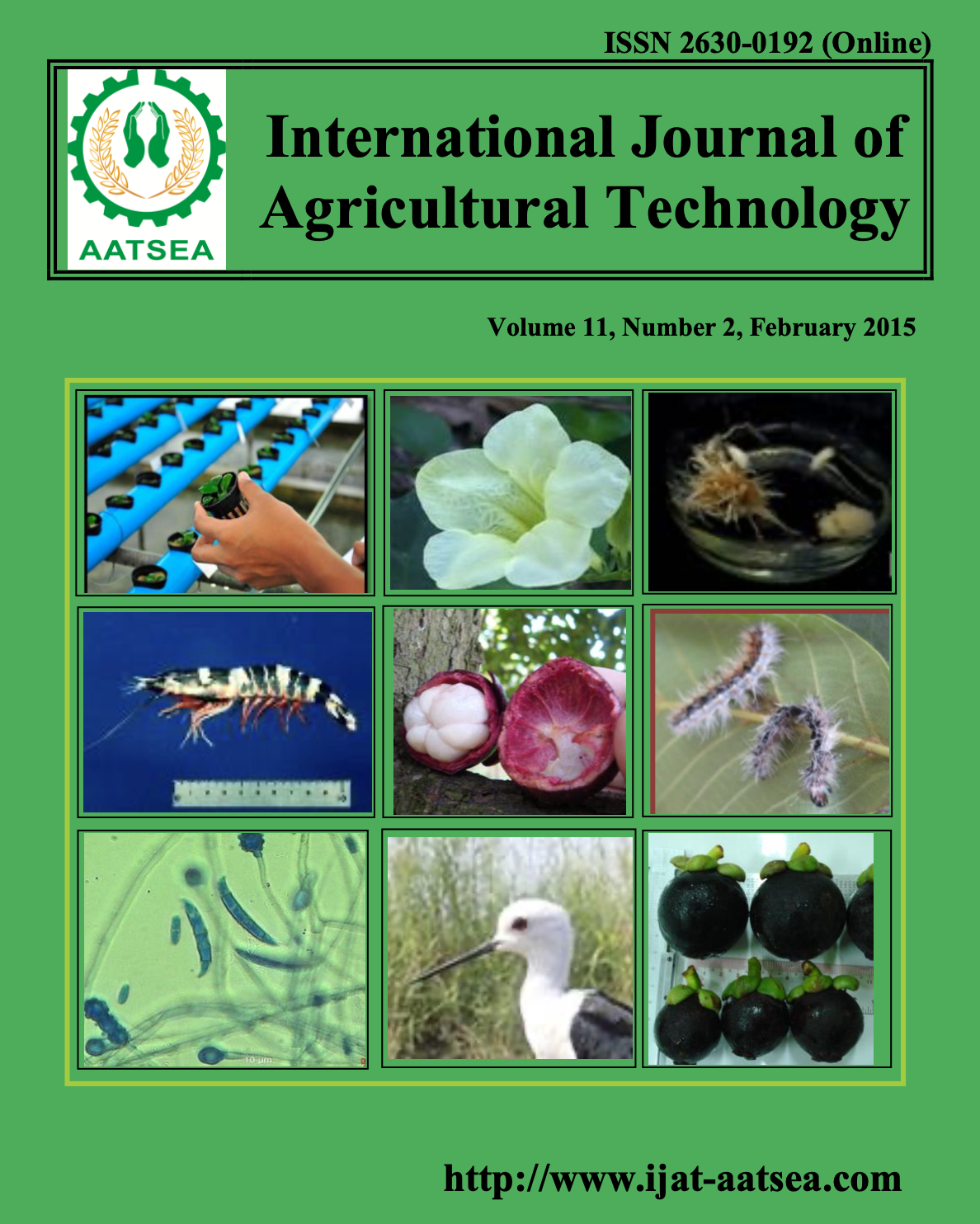Evaluation of two species of Trichoderma as compost activator and bio-control agents
Main Article Content
Abstract
The two Trichoderma species were found to be viable in improving the composting efficiency of the compost especially when the Trichoderma sp. 2 was inoculated on the compost. Trichoderma sp. 2 increased the total NPK content of the compost at 4.88% with the C: N ratio of 6:1. Combination of the two species of Trichoderma could also increase the nutrient content of the compost with 4.48% with the high percentage recovery of 67%. However, compost inoculated with Trichoderma sp. 1 had the lowest total NPK content of 3.68% as compared with the compost not inoculated with activator (3.93%). The two Trichoderma species had the ability to inhibit the mycelia growth of S. rolfsii by 34.92% and 31.44%, respectively. The two Trichoderma were able to produce metabolites, by inhibiting the growth of S. rolfsii by 10.46% to 29.03% in volatile, 3.74% to 5.59% in non-volatile, and 11.3% to 12.94% in direct-diffusible metabolite. Biological activity of Trichoderma on seed coating treatment showed enhancement of the seed germination of cucumber when the seeds were coated with Trichoderma sp. 1 (93.75%) alone, or coated with Trichoderma sp. 1 + Trichoderma sp. 2 (84.38%). Biological activity of the Trichoderma on soil treatment revealed that seeds sowed in any of the infected or non-infected soil treated with the two species of Trichoderma either alone or in combination enhanced the seed germination of cucumber by 87.50% to 93.75%. Disease incidence in cucumber was high even in the presence of Trichoderma sp. 1; however application of the two species of Trichoderma reduced the incidence of damping off disease by 6.25%. Trichoderma species were found effective as compost activator in rice straw-based compost as it enhance the nutrient content of the compost. Likewise it produce different amount of metabolites that inhibit the growth of S. rolfsii. The two species ofTrichoderma also helped to improve seed germination and reduce the disease incidence of cucumber in seed and soil treatment application.
Article Details

This work is licensed under a Creative Commons Attribution-NonCommercial-NoDerivatives 4.0 International License.
References
Adani, F., Genevini, P. L., Gasperi, F. and Zorzi, G. (1997). Organic matter evolution index as measure of composting efficiency. Compost Science and Utilization 5:53-62.
Alvindia, D. G. and Natsuaki, K. T. (2008). Evaluation of fungal epiphytes isolated from banana fruit surfaces for bio-control of banana crown rot disease. Crop Protection 27:1200-1207.
Choudary, K. A., Reddy, K. R. N. and Reddy, M. S. (2007). Antifungal activity and genetic variability of Trichoderma harzianum isolates. Journal of Mycology and Plant Pathology 37:1-5.
Edington, L. V., Knew, K. L. and Barron, G. I. (1971). Fungi toxic spectrum of benzimidazole compounds. Phytopathology 61:42-44.
Gajera, H., Domadiya, R., Patel, S., Kaporara, M. and Golakiya, B. (2013). Molecular mechanisms of Trichoderma harzianum as bio-control agent against phytopathogen system - a review. Current Research in Microbiology and Biotechnology 1:133-142.
Gajera, H. P., Bambharolia, R. P., Patel, S. V., Khatrani, T. J. and Goalkiya, B. A. (2012). Antagonism of Trichoderma spp. against Macrophomina phaseolina: Evaluation of coiling and cell wall degrading enzymatic activities. Journalof Plant Pathology and Microbiology. pp. 3-7.
Goyal, S. and Sindhu, S. S. (2011). Composting of rice straw using different inocula and analysis of compost quality. Indian Microbiology Journal 1:126-138.
Harman, G. E. (2000). Myths and dogmas of bio-control: Changes in perceptions derived from research on Trichoderma harzianum T22. Plant Disease 84:377-393.
Harman, G. E., Bjorkman, T., Ondik, K. and Shoresh, M. (2008). Changing paradigms on the mode of action and uses of Trichoderma sp. for bio-control. Outlooks on Pest Management. Research Information 10:1564.
Jegathambigai, V., Wijeratnam, S. W. and Wijusundera, R. L. C. (2010). Effect of Trichoderma sp. on Sclerotium rolfsii, the causative agent of collar rrot on Zamioculcas zamiifolia and an on farm method to mass produce Trichoderma species. Plant Pathology Journal 9:47-55.
Manjula, K., Kishore, G. K. and Podile, A. R. (2004). Whole cells of Bacillus subtilis AF1 proved more effective then cell-free and chitinase based formulated in bio-control of citrus fruit rot and ground rust. Journal of Microbiology 50:737-744.
Mascarin, G. M., Junior, M. F. B. and Araujo, J. V. (2012). Trichoderma harzianum reduces population of Meloidogyne incognita in cucumber plants under greenhouse conditions. Journal of Entomology and Nematology 4:54-57.
Motlagh, M. S. and Samimi, Z. (2013). Evaluation of Trichoderma spp. as biological agents in some of plant. Journal of Annals of Biological Research 4:173-179.
Ponce, E. R. (2004). Special Issues in Agriculture. Philippine Institute for Development Studies and Bureau of Agricultural Research, Makati City, Philippines. 774 pp.
Silva, R. N., Silva, S. P., Brandao, R. L. and Ulhoa, C. J. (2004). Regulation of N-acetyl-beta- D-glucosaminidase produced by Trichoderma harzianum: evidence that cAMP controls its expression. Journal of Research Microbiology 155:667-671.
Sancom, A., Sopajaree, K. and Cheunbarn, T. (2006). Effect of temperature on total organic carbon degradation using Trichoderma fungal in co-composting of straw and hospital sewage sludge. Journal on Sustainable Energy and Environment. pp. 21-23.
Tallapragada, P. and Gudimi, M. (2009). Phosphate solubility and bio-control activity of Trichoderma harzianum. Journal of Phytopathology 22:837-845.
Tayung, K., Barik, B. P. and Jha, D. K. (2012). Antifungal activity and biocontrol potential of metabolite produced by an endophytic Fusarium (MTCC-9622) against some postharvest pathogens. Journal of Agricultural Technology 6:409-419.


